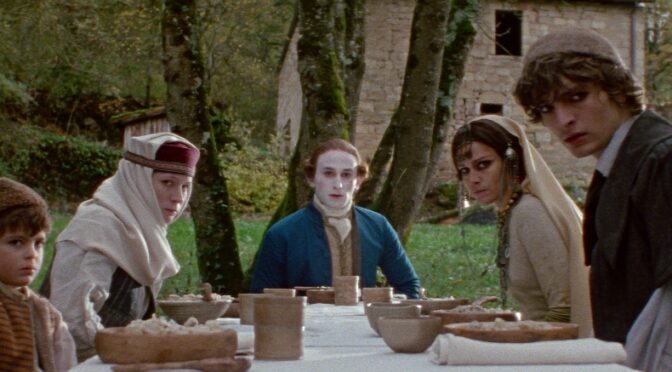 Adapted from A. K. Tolstoy’s 19th-century novella La Famille du Vourdalak, THE VOURDALAK is a gothic feature debut from director Adrien Beau. Though the film doesn’t entirely come together, and the central horror element is often more silly than horrifying, there’s some interesting imagery and a fascinating queer allegory in this proto-vampire story.
Adapted from A. K. Tolstoy’s 19th-century novella La Famille du Vourdalak, THE VOURDALAK is a gothic feature debut from director Adrien Beau. Though the film doesn’t entirely come together, and the central horror element is often more silly than horrifying, there’s some interesting imagery and a fascinating queer allegory in this proto-vampire story.
Marquis Jacques Antoine Saturnin d’Urfé (Kacey Mottet Klein), a diplomatic envoy of the King of France, finds himself lost without his horse or belongings. He’s a foppish fellow, more at home at a royal ball than in the woods of Eastern Europe. He’s directed to the house of Gorcha, where he finds a family waiting for their patriarch to return, having set out for battle, leaving the enigmatic instructions that they shouldn’t open the door to him if he returns after six o’clock on the sixth day. The Marquis discovers more about the family and especially the enigmatic daughter Sdenka (Ariane Labed) until the sixth bell tolls and Gorcha (Adrien Beau) – or whatever Gorcha has become – returns home.
The sense of gothic strangeness at the heart of THE VOURDALAK comes across most strongly in the many scenes of the Marquis encountering the family members in the woods. These scenes evoke horror films like Ken Russell’s THE LAIR OF THE WHITE WORM. And yet this strangeness never settles into a familiar rhythm, instead dancing around a sense of horror that never quite clicks. The film is strongest when it leans into a sense of dream-like weirdness, but a narrative grounding in reality keeps it from those heights too often.
This tonal dissonance becomes even more acute when the vourdalak appears with a weird aesthetic that teeters between sinister and silly. While there is a certain charm to the analogue visual effects and the puppetry, the vourdalak’s appearance – somewhere between a figure from a Jan Švankmajer film and a skeleton drawn by Mike Mignola – feels out of place in a jarring way. Arguably, that’s the point: positioning this supernatural figure apart from the mundane world of the family and the Marquis. Still, the image is so dissonant that it pulls the viewer out of the film.
Despite these flaws, there’s an interesting queer allegory in THE VOURDALAK. The evil of the vourdalak is embodied in the family patriarch and primarily consists of enforcing the values of traditional family and the strength of the household. There is a contrast with the figures who stand against the monster: the effeminate Marquis, the unmarried daughter Sdenka, and the androgynous son Piotr (Vassili Schneider), whom the Marquis initially confuses for a woman. The film positions these figures outside the traditional roles of the family, and it’s these three who attempt to resist the poisonous (conservative) influence of the vourdalak on the rest of the household to, as the Marquis says to Sdenka, “live as you please”.
While THE VOURDALAK may not entirely succeed as a film, there is something fascinating about how this early vampire story emphasises the queerness that has always been part and parcel of vampire stories in folklore.

